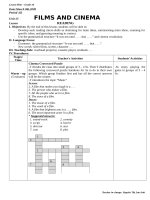Unit 13. Films and cinema
Bạn đang xem bản rút gọn của tài liệu. Xem và tải ngay bản đầy đủ của tài liệu tại đây (2.66 MB, 23 trang )
WARM –UP:
What kind of film do the following
pictures belong to?
Cartoon film
Cartoon film
Detective film
Action film
Action film
Science fiction film
Science fiction film
Love story film
Love story film
Unit 13
Part A: Reading
1. Do you want to see a film at
the cinema or on TV? Why?
2. Can you name some of the
films you have seen?
3. Which film do you like best?
I. BEFORE YOU READ
1. WORK IN PAIRS: ANSWER THE QUESTIONS
2. Vocabulary
audience ['ɔ:djəns] (n) : khán giả
How do you call a person
who makes films?
a. film maker Người làm phim(n)
Eg: He has just replaced an old bike with a new one.
3 Replace /ri'pleis/ (v) :Thay thế
4 Rapidly /'ræpidli/ (adv) = quickly: : Một cách nhanh chóng
5 Decade /'dekeid/ (n): = 10 years Thập niên
6 Character /'kæræktə/ (n):
Eg: Truc and Nam are two main characters in
“Suddenly, I want to cry” film.
7. Scene / si:n/ (n):
9. Sequence / 'si:kwəns/(n):
8. Motion / 'məʊʃn /(n):
Nhân vật
the act or process of moving:
Cảnh phim
Sự di động, sự chuyển động
Chuỗi
3 Replace /ri'pleis/ (v): :Thay thế
4 Rapidly /'ræpidli/ (adv): Một cách nhanh chóng = quickly
5 Decade /'dekeid/ (n): Thập niên = 10 years
6 Character / 'kæræktə / (n): Nhân vật
7. Scene / si:n/ (n):
9. Sequence / 'si:kwəns/(n): Chuỗi
8. Motion / 'məʊʃn /(n): Sự di động, sự chuyển động
Cảnh phim
2.film maker (n) Người làm phim
1.audience ['ɔ:djəns] (n) : khán giả
Task 1: Match the words in the box with their given
definitions.
1. ________
film - making industry
2. ________
series of related events or actions
3. ________
a period of ten years
4. ________
quickly and in a short time
5. ________
part of a film
6. ________
a person in a film.
C- cinema
D- sequence F- decade
A- rapidly B- scene
E- character
Task 2: Work in groups: Answer the following questions
1. When did the history of cinema begin?
2. Did films in the early days have sound?
3. When were audiences able to see long films?
4. When was sound introduced?
0002
03
10
04
08
05090607
01
11
12
13141617181920212223242515
The history of what we call cinema today began in the early 19
th
century. At that time, scientists discovered that when a sequence of still
pictures were set in motion, they could give the feeling of movement. In
the first two decades of its existence, the cinema developed rapidly. In
those early days, films were little more than moving photographs,
usually about one minute in length. By 1905, however, films were about
five or ten minutes long. They used changes of scence and camera
positions to tell a story, with actors playing character parts. In the early
1910s, audiences were able to enjoy the first long films, but it was not
until 1915 that the cinema really became an industry. From that time,
film makers were prepared to make longer and better films and build
special places where only film were shown. The cinema changed
completely at the end of the 1920s. This was when sound was
introduced. The change began in America and soon spread to the rest
of the world. As the old silent films were being replaced by spoken ones
on the screen, a new cinema form appeared, the musical cinema.
1. When did the history of cinema begin?
In the early 19
th
century.
The history of what we call cinema today began in the early 19
th
century. At that time, scientists discovered that when a sequence of still
pictures were set in motion, they could give the feeling of movement. In
the first two decades of its existence, the cinema developed rapidly. In
those early days, films were little more than moving photographs,
usually about one minute in length. By 1905, however, films were about
five or ten minutes long. They used changes of scence and camera
positions to tell a story, with actors playing character parts. In the early
1910s, audiences were able to enjoy the first long films, but it was not
until 1915 that the cinema really became an industry. From that time,
film makers were prepared to make longer and better films and build
special places where only film were shown. The cinema changed
completely at the end of the 1920s. This was when sound was
introduced. The change began in America and soon spread to the rest
of the world. As the old silent films were being replaced by spoken ones
on the screen, a new cinema form appeared, the musical cinema.
2. Did films in the early days have sound?
No, they didn’t.
The history of what we call cinema today began in the early 19
th
century. At that time, scientists discovered that when a sequence of still
pictures were set in motion, they could give the feeling of movement. In
the first two decades of its existence, the cinema developed rapidly. In
those early days, films were little more than moving photographs,
usually about one minute in length. By 1905, however, films were about
five or ten minutes long. They used changes of scence and camera
positions to tell a story, with actors playing character parts. In the early
1910s, audiences were able to enjoy the first long films, but it was not
until 1915 that the cinema really became an industry. From that time,
film makers were prepared to make longer and better films and build
special places where only film were shown. The cinema changed
completely at the end of the 1920s. This was when sound was
introduced. The change began in America and soon spread to the rest
of the world. As the old silent films were being replaced by spoken ones
on the screen, a new cinema form appeared, the musical cinema.
3. When were audiences able to see long films?
They were able to see long films in the early 1910s
The history of what we call cinema today began in the early 19
th
century. At that time, scientists discovered that when a sequence of still
pictures were set in motion, they could give the feeling of movement. In
the first two decades of its existence, the cinema developed rapidly. In
those early days, films were little more than moving photographs,
usually about one minute in length. By 1905, however, films were about
five or ten minutes long. They used changes of scence and camera
positions to tell a story, with actors playing character parts. In the early
1910s, audiences were able to enjoy the first long films, but it was not
until 1915 that the cinema really became an industry. From that time,
film makers were prepared to make longer and better films and build
special places where only film were shown. The cinema changed
completely at the end of the 1920s. This was when sound was
introduced. The change began in America and soon spread to the rest
of the world. As the old silent films were being replaced by spoken ones
on the screen, a new cinema form appeared, the musical cinema.
4. When were sound introduced?
The sound were introduced at the end of the 1920s.
Task 3: Choosse the best title
A. The Story of a Film Maker
B. A Brief History of Cinema
C. The History of the Film Industry
After you read
After you read
Talk about the passage, using the cues
a.19th century/ history/cinema/ began
b.1905/ films/ five/ ten minutes
c.1910s/ audiences/able/ enjoy/ long films
d.1915/ cinema/ became/ industry
e.1920s/ cinema/changed
Homew or k
Learn by heart the
vocabulary.
Answer the questions 2 and 6
in task 2 in the textbook.
Prepare for your speaking
activity.
23









